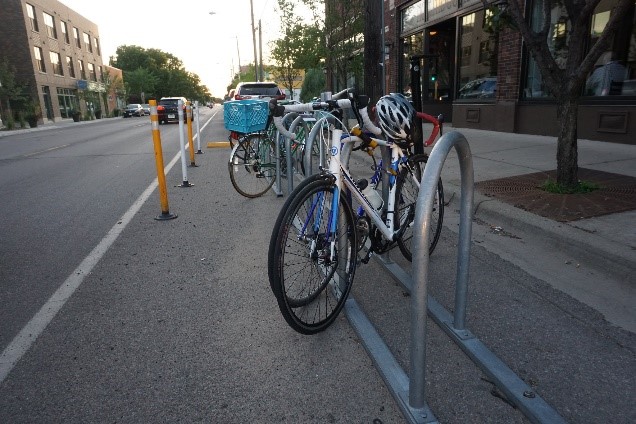3.3H Bicycle and micro mobility parking
Search Content
Download PDF
Print Guide
Introduction
The proliferation of different types of vehicles, including scooters, bikeshare, and other new vehicle types increase the need for safe spaces to park these vehicles. The City currently operates five accommodations for bike and micromobility parking:
Bike rack program – The Bike Rack Cost Share program allows eligible businesses to be reimbursed up to 50% of the bicycle rack cost and 50% of the installation cost. Schools, libraries, parks, and other eligible public facilities can request to receive racks at no cost. Contact the City for more details on bike rack and bicycle corral cost share programs.
Bike corral program – The Bicycle Corral Cost Share Program is designed for businesses with high bicycle demand and limited space in the boulevard or sidewalk area. It is a low-cost method to provide bicycle parking in the same space occupied by an on-street parked car. Businesses are reimbursed for up to 50% of the bike corral cost.
Bike lockers – Public bike lockers are available to rent at some locations including, Ramp A, Courthouse Ramp, the University of Minnesota, and at Metro Transit stations and transit centers.
Nice Ride station placement – Nice Ride has both stations for docked bicycles and dockless pedal-assist ebikes. Their use of stations, docks, or racks may evolve in the future.
Scooter parking zones – the City has created several temporary on-street scooter parking zones to provide a designated space for scooters to be parked, although generally scooters use bicycle parking spaces.
Bicycle and micromobility parking will be installed with all capital street projects; additional guidance will be added in the future. See Transportation Action Plan Bicycle strategy 9 for more actions related to bicycle and micromobility parking.
Design Considerations
|
Location |
Bicycle and micromobility parking can be located in the boulevard and furnishing zone, the frontage zone, or as on-street corrals in the roadway zone.
|
|
Maintaining pedestrian clear zones |
A minimum 6’ pedestrian clear zone must be retained adjacent to bicycle racks to ensure that a minimum ADA access is retained when bicycles are parked as parked bicycles may extend into the pedestrian clear zone. See sidewalk zone design guidance for recommended pedestrian clear zone widths by street type. |
|
Clearances |
Minimum distance between bicycle rack (not a bicycle parked at the rack) and existing element:
|
|
Spacing |
Recommended spacing between racks is 3’-4’ if adjacent to each other. |
|
On-street bicycle corrals |
An on-street bicycle parking corral is a group of bicycle racks installed adjacent to the curb in the parking lane of a roadway. View detailed information for on-street bicycle parking corrals. |




